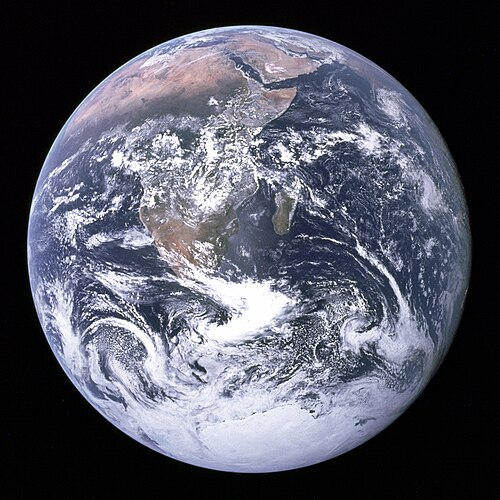Facts for Kids
Earth is the third planet from the Sun and is unique among the planets in our solar system for its ability to support life, featuring a diverse range of ecosystems and natural resources.
Overview
Plate Tectonics
Natural Resources
Earth's Atmosphere
Exploration Of Earth
The Layers Of The Earth
Human Impact On The Earth
Biodiversity And Ecosystems
Climate And Weather Patterns

Inside this Article
The Amazon Rainforest
North American Plate
Great Barrier Reef
Technology
Atmosphere
Recycling
Climate
Nickel
Marble
Did you know?
🌍 Earth is the third planet from the Sun and the only known planet to support life.
💧 About 71% of Earth's surface is covered by water, primarily in the form of oceans.
🌡️ Earth has an average temperature of approximately 15 degrees Celsius (59 degrees Fahrenheit).
🌌 The Earth rotates on its axis at about 1670 kilometers/hour (1040 miles/hour) at the equator.
🌞 Earth is the densest planet in the Solar System and has a strong magnetic field.
🌕 The Moon, Earth's only natural satellite, is about 1/6th the size of Earth.
🌀 Earth has a diverse range of ecosystems, including deserts, rainforests, and polar regions.
🌈 The atmosphere is composed mainly of nitrogen (78%) and oxygen (21%), with traces of other gases.
🌠 Earth experiences around 5,000 million lightning strikes per year.
🌎 Life on Earth is incredibly diverse, with millions of species of plants and animals identified so far.
Introduction
What makes Earth even cooler is that it has one moon, which helps control the tides in our oceans. Isn't that fascinating?
Plate Tectonics
These plates float on the liquid mantle below and can move, which sometimes causes earthquakes! 🤯
There are seven major plates, like the North American Plate and the Pacific Plate. When these plates push together, mountains can form, like the Himalayas, where Mount Everest sits—the highest mountain in the world at 29,029 feet tall! 🏔
️ Learning about plate tectonics helps us understand how our Earth changes and evolves over time.
Natural Resources
Some examples are water, minerals, and plants. 🌊
We use freshwater from rivers and lakes for drinking and farming. Oil and coal are fossil fuels found deep in the ground; we use them to power vehicles and heat our homes. 🌿
Trees provide wood for building and oxygen for us to breathe! We must care for our natural resources by recycling and conserving them, so they last for future generations. 🌳✨ Remember, every time we recycle, we’re helping our planet!
Earth's Atmosphere
️ It’s made up of 78% nitrogen, 21% oxygen, and small amounts of other gases. The atmosphere is divided into five parts: the troposphere, stratosphere, mesosphere, thermosphere, and exosphere. The troposphere, where the weather happens, is about 8 to 15 miles thick! ☁
️ Without the atmosphere, Earth would be too cold and wouldn’t support life. The oxygen we breathe comes from plants, especially trees like the mighty oak! 🌳
Isn’t nature amazing?
Exploration Of Earth
From early explorers like Marco Polo to modern astronauts, people have discovered new lands and views of our planet. The oceans are still partly unexplored, with scientists believing that 80% of the sea remains a mystery! 🌊
Space missions, like those from NASA, send satellites to observe Earth and help us understand its climate. 📡🌌 The famous picture, “Earthrise,” taken during the Apollo 8 mission in 1968, showed Earth rising over the Moon's horizon. Exploring the Earth helps us appreciate and protect our amazing home!
The Layers Of The Earth
The outer layer is called the crust. This is where we live and walk around on land. ⛰
️ Underneath is the mantle, which is super hot and mostly made of liquid rock, called magma. Next is the outer core, made of liquid iron and nickel, and finally, the inner core is a solid ball of iron as hot as the Sun’s surface! 🌞
The crust is about 20 miles thick, while the inner core reaches temperatures of around 9,932°F (5,500°C). Earth’s layers work together to create everything we see!
Human Impact On The Earth
️ We build cities and create technology, but these can harm the environment. Pollution from factories and vehicles can harm air and water quality. 🌫
️ Deforestation, or cutting down trees, can endanger animals and change ecosystems. However, we can help protect our planet by recycling, using less plastic, and planting trees! 🌳
Did you know that in 2020, around 55 billion plastic bottles were used every year? Making smart choices helps make our Earth a cleaner, healthier place for everyone!
Biodiversity And Ecosystems
Ecosystems are communities where living things interact with each other and their environment! 🌼
Each ecosystem, like forests, deserts, and oceans, has its own special creatures. For example, the Great Barrier Reef in Australia is home to thousands of marine life, including colorful corals and fish. 🐠
Protecting biodiversity is important because every species has a role in nature, creating a balance that supports life. More than 1.5 million species have been identified, but scientists think there could be millions more!
Climate And Weather Patterns
️🌧️ Earth has many climates: tropical, arid (like deserts), and polar (like the Arctic)! For example, the Amazon Rainforest in South America is very humid and has lots of rain, while the Sahara Desert is hot and dry! 🌵
Weather affects what people wear and what activities we do. Storms, like hurricanes, can be dangerous, so we need to be prepared. 🌪
️ Understanding climate and weather helps us adapt to our changing world!

